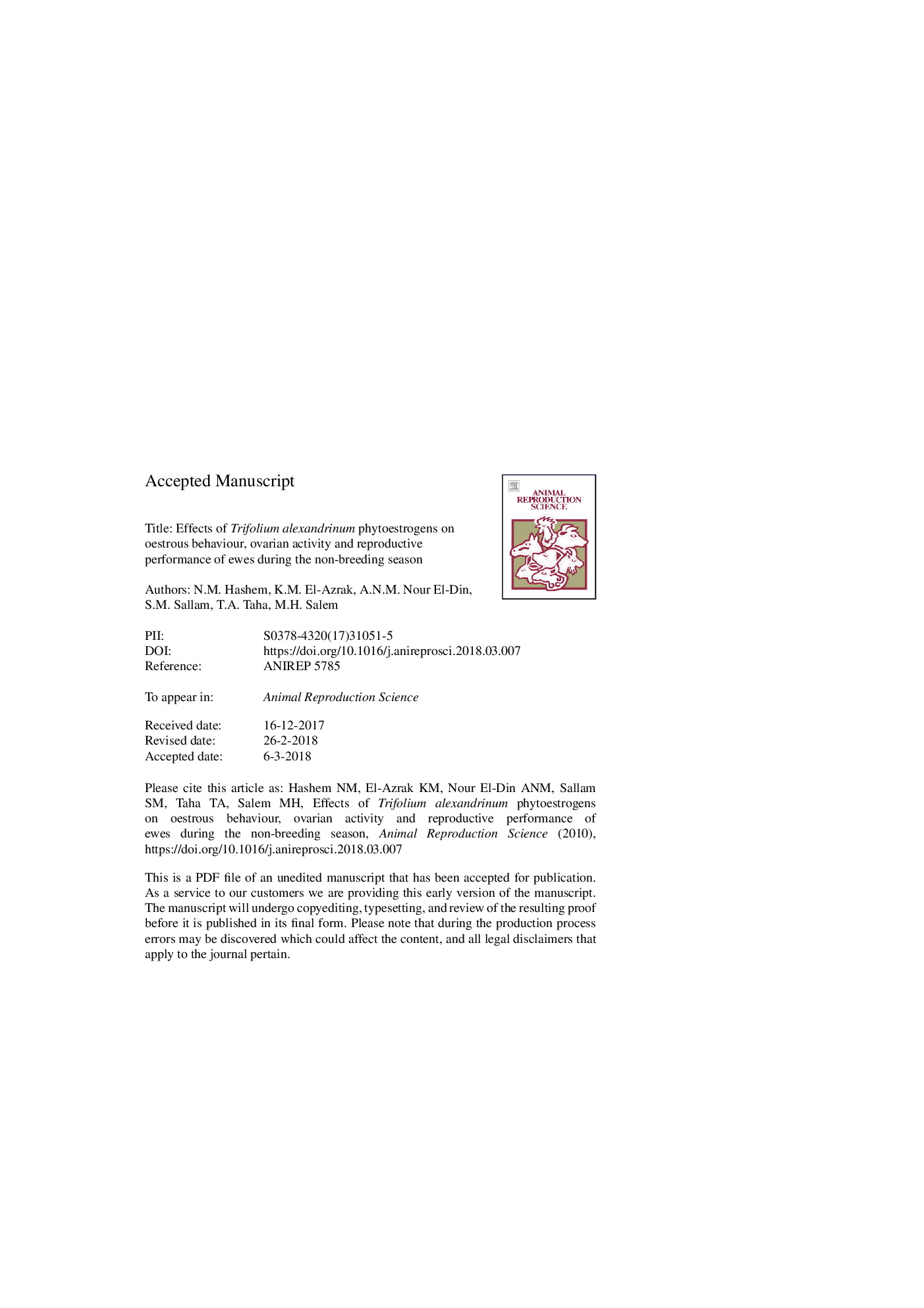| کد مقاله | کد نشریه | سال انتشار | مقاله انگلیسی | نسخه تمام متن |
|---|---|---|---|---|
| 8949556 | 1645718 | 2018 | 23 صفحه PDF | دانلود رایگان |
عنوان انگلیسی مقاله ISI
Effects of Trifolium alexandrinum phytoestrogens on oestrous behaviour, ovarian activity and reproductive performance of ewes during the non-breeding season
دانلود مقاله + سفارش ترجمه
دانلود مقاله ISI انگلیسی
رایگان برای ایرانیان
کلمات کلیدی
موضوعات مرتبط
علوم زیستی و بیوفناوری
علوم کشاورزی و بیولوژیک
علوم دامی و جانورشناسی
پیش نمایش صفحه اول مقاله

چکیده انگلیسی
Phytoestrogens are classified as naturally occurring endocrine disrupting chemicals that may affect reproductive performance of farm animals. To investigate the effects of Berseem clover phytoestrogens on reproductive performance of seasonal anoestrus ewes, twenty four late pregnant Rahmani ewes were fed either Berseem clover or maize silage (nâ¯=â¯12/treatment). Treatment started 2 months prepartum and continued until oestrous induction (week 8 postpartum), using the CIDR-eCG based protocol, and early pregnancy. Throughout the 2-8 weeks postpartum, oestrous rate and ovarian activity were not affected by treatment. After oestrous induction, ewes in both groups expressed comparable oestrous rates; however feeding Berseem clover extended (Pâ¯<â¯0.05) interval to oestrus (57.00 compared with 42.54â¯h) and shortened (Pâ¯<â¯0.05) oestrous duration (20.0 compared with 34.90â¯h). Feeding Berseem clover did not affect follicular activity except the number of medium follicles, which was less (Pâ¯<â¯0.05) on day of oestrus (Day 0). Feeding maize silage increased (Pâ¯<â¯0.05) the total number of follicles and number of small and medium follicles the day before oestrus (Day -1). On Day 0, the greater total number of follicles was due to the greater (Pâ¯<â¯0.05) number of medium follicles that was associated with less number of small follicles. Although, the number and diameter of corpora lutea (CLs) were not affected by treatment, serum P4 concentration was greater (Pâ¯<â¯0.05) for ewes fed maize silage than for those fed Berseem clover. Fecundity and litter size tended to be greater (about 35%; Pâ¯=â¯0.132 and 0.085, respectively) in the maize silage fed ewes. In conclusion, feeding Berseem clover throughout seasonal anoestrus disrupted aspects of behavioural oestrus and there was less luteal P4 synthesis and fecundity of ewes.
ناشر
Database: Elsevier - ScienceDirect (ساینس دایرکت)
Journal: Animal Reproduction Science - Volume 196, September 2018, Pages 1-8
Journal: Animal Reproduction Science - Volume 196, September 2018, Pages 1-8
نویسندگان
N.M. Hashem, K.M. El-Azrak, A.N.M. Nour El-Din, S.M. Sallam, T.A. Taha, M.H. Salem,